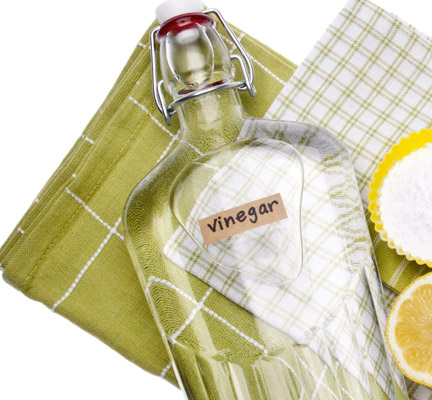Vinegar is a very popular ingredient in DIY cleaners. It is hailed as a “cure all” when it comes to many cleaning dilemmas. As a result, we were eager to test the effectiveness of vinegar and its germ-killing abilities.

Testing
We tested distilled white vinegar (the 5% acidity variety you can find at a grocery store) on a smooth, stainless steel surface and used E. coli and other bacteria to test vinegar’s germ-killing abilities (see Sidebar: “TURI’s Testing Process for Greener Disinfectants”). We applied vinegar to the surface and observed contact times of .5, 1, 3, and 5 minutes. What were our overall findings?
The bottom line, vinegar does kill germs including bacteria and viruses. We infer that the acetic acid in vinegar denatures (chemically changes) the proteins and fats that make up these organisms resulting in their death.
Sanitizing with Vinegar
For the best results, you’ll want to clean the surface before you use vinegar as a sanitizer. You can use vinegar to clean the surface, or another green cleaner, by spraying the solution onto a microfiber cloth, and then wiping the surface. Next, spray vinegar directly onto the surface and let the solution set - and stay wet - for from 30 seconds to 3 minutes or more (the longer the better).
After the time has elapsed, use a clean side of your microfiber cloth to wipe up the vinegar. This method will ensure the most germ removal without using harsh disinfectants.
Do remember though, that while vinegar does kill germs, it doesn’t kill all germs. This is where caution is needed. In our testing, we found that some bacteria were likely unaffected by exposure to vinegar. This fact emphasizes that vinegar may not be the best disinfectant for your cutting boards that handle raw meat.*
Conclusion
Overall, we think vinegar is good sanitizer to supplement the germ removal process through physical cleaning. However, on surfaces where disinfection is crucial, such as cutting boards and kitchen surfaces, a stronger disinfectant may be warranted. A thorough washing and scrubbing with hot soap and water may help the most.
*This study focused primarily on vinegar’s germ-killing abilities. Vinegar can also be an effective acidic cleanser, i.e., to remove light scale and soap scum residue in bathrooms.
Disclaimer: While effort is made to ensure the accuracy and quality of the content, HC, UML TURI and IEHA are not providing professional or health advice, and offer no warranty - expressed or implied - and assume no legal liability for the accuracy, completeness, usefulness or safety of any information, product or process disclosed in conjunction with the content above. The views and opinions of the authors or originators expressed herein do not necessarily state or reflect those of the HC, UML TURI or IEHA organizations.









